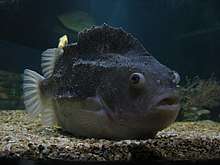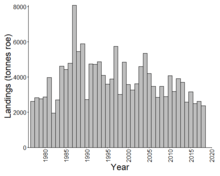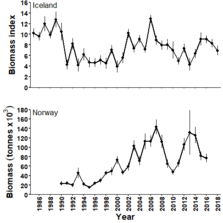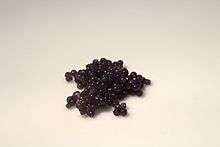Cyclopterus lumpus
Cyclopterus lumpus, the lumpsucker or lumpfish, is a species of marine fish in the family Cyclopteridae (lumpsuckers). It is the only member of the genus Cyclopterus.[1] It is found in the North Atlantic and adjacent parts of the Arctic Ocean, ranging as far south as Chesapeake Bay (rare south of New Jersey) on the North American coast and Spain (rare south of the English Channel) on the European coast.[2][3]
| Cyclopterus lumpus | |
|---|---|
 | |
| Adult at the Dorée Tropical Aquarium | |
.jpg) | |
| Juvenile | |
| Scientific classification | |
| Kingdom: | |
| Phylum: | |
| Class: | |
| Order: | |
| Family: | |
| Genus: | Cyclopterus |
| Species: | C. lumpus |
| Binomial name | |
| Cyclopterus lumpus | |
Description
Lumpfish are sexually dimorphic with females reaching larger sizes than the males. Males typically reach 30–40 cm (12–16 in) in length while females can typically grow up to 50 cm (20 in) in length and 5 kg (11 lb) in weight.[4] The largest specimen recorded measured 61 cm (24 in) in length,[3] and 9.6 kg (21 lb) in weight.[5] In the brackish water of the Baltic Sea, it usually does not surpass 20 cm (8 in).[4] The body is ball-like. It has a knobbly, ridged back and three large bony tubercles on each flank. Its pelvic fins form suction discs which it uses to attach strongly to rocks or other surfaces. The head and the pectoral fins of males are larger than those of females. It has a jelly-like layer of fat under the skin. Its colour is highly variable; bluish, greyish, olive, yellowish or brownish.[6] Mature males turn orange-reddish during the breeding season.[6]
Biology
After hatching, lumpfish will spend their first few months in tidal pools,[7] or in association with floating seaweed clumps.[8] As they grow they migrate out into open water far from land where they live in the pelagic zone[9] feeding upon gelatinous zooplankton, fish eggs and small crustaceans.[10] When they reach maturity they will migrate to coastal areas in spring to breed. The population spawns over many months with spawning fish being caught in Iceland from March until August.[11] Females which have spawned during the previous year tend to return to the same area when spawning again. They will also return at a similar time of year i.e. individuals which spawned early and late in the season will return to spawn early and late in the season the following year [12]. A single female will lay 50,000–220,000 eggs which are laid in two batches of roughly equal size 1–2 weeks apart.[13][14][11] The eggs are between 2.2 and 2.5 mm in diameter and the ovary can account for up to one third of the weight of the female fish before spawning.[11] The female will lay the eggs in a nest area pre-selected by the male, which will usually consist of a rocky outcrop or boulders on the seabed.[15] The nest is in relatively shallow water (<10 m) and may even be in the intertidal zone.[15] The male also guards and cares for the eggs by fanning them with his fins during the month-long incubation period.[15]
Several aspects of their biology (i.e. lack of a swimbladder, its pelvic suction disc) led some to believe that they were a bottom dwelling species.[16] Lumpfish are frequently caught in pelagic fishing nets,[17][18] however, capture in bottom trawls is also common.[19][20] An investigation using electronic data-storage tags attached to the fish have confirmed that, at least during its breeding migration, this fish will spend time associated with the sea bed, and also some time in the pelagic zone.[21] As the fish came close to breeding, they began to spend a greater amount of time in the pelagic zone. With the lack of a swim bladder, the fish were able to make rapid movements through the water column, moving between surface waters and depths of over 300 m (980 ft) within one day. Data from research surveys and data-storage tags show that adult lumpfish alter their behaviour between night and day with the fish spending more time in the pelagic zone at night and found associated with the seabed during the day, the reasons for this are unclear.[19][21] This fish is now considered to be a semi-pelagic/semi-demersal fish.
Fishery

Landings of lumpfish roe varied from approximately 2000-8000 tonnes from 1977-2018. In recent years, Iceland and Greenland have been the two largest fishing nations in regards to lumpfish and account for >95% of the global catch[22][23]. Historically, Norway and Canada also contributed significant amounts but due to a decrease in the price of salted roe, and a severe population decline in Canada,[24] the contribution from these countries has decreased[22]. Denmark and Sweden have also contributed but the amount has been low in comparison with the other countries.[23] Female fish are the main target for the fishery which utilizes the roe to make lumpfish caviar.[23] Lumpfish are targeted close to the shore, where they come to spawn, using small fishing boats (generally less than 15 m or 49 ft) with large mesh gillnets.[23] Due to the smaller size of the male, very few are caught in the large meshes. Traditionally, the roe would be removed at sea and the bodies disposed of. In Iceland, it is now mandatory for the bodies to be landed;[25] these are now frozen and exported, mainly to China.
In Iceland, there is also the tradition of catching the male fish, mainly for the local market. This is done using gillnets with a smaller mesh size than that used for the females. The males are targeted in January–February, which is earlier than the females which are targeted from March until August.
Population status

In both Iceland and Norway, the population is monitored using data from scientific surveys and is currently above the long term average and considered to be healthy. In Greenland, no survey data is available and data on fishing effort and landings are monitored. The time series is short for this population however appears to be stable. The population in Canada appears to be depleted and the Committee on the Status of Endangered Wildlife in Canada (COSEWIC) has classified this as threatened. There is a lack of data to reliably assess the abundance of lumpfish in the North Sea or Baltic Sea thus the population status of this area is unknown. The fishery in Greenland and Norway was certified by the Marine Stewardship Council in 2015 and 2017 respectively with these certifications being valid for 5 years. The fishery in Iceland was certified in 2014 but this was suspended in 2018 due to issues surrounding bycatch.
Uses

The roe of the fish, a good source of omega-3 fatty acids, is used to produce relatively inexpensive imitation "caviar". The roe is removed from the fish and processed to remove connective tissue. The roe is stored in large barrels where it is salted. The roe is dyed either red or black and packed with a mould inhibitor such as sodium benzoate (E211).[26] In Scandinavia the flesh of the fish is eaten.[3] In Iceland, the males are often salted and smoked, or simply boiled. The female lumpfish is rarely eaten fresh but when it is caught during the spawning season, the guts and head removed, scored deeply with a knife and hung in a cool place until the flesh turns yellow. The fish is then poached before serving which is called sigin grásleppa in Icelandic.
They are used as "cleaner fish" to reduce the parasite burden on salmon farms in Scotland, Iceland and Norway.[27]
References
- Froese, Rainer and Pauly, Daniel, eds. (2012). Species of Cyclopterus in FishBase. July 2012 version.
- Heessen, Henk J.L.; Daan, Niels; Ellis, Jim R., eds. (2015). Fish atlas of the Celtic Sea, North Sea, and Baltic Sea: Based on international research-vessel surveys. The Netherlands: Wageningen Academic Publishers. doi:10.3920/978-90-8686-266-5. ISBN 9789086862665.
- Froese, Rainer and Pauly, Daniel, eds. (2012). "Cyclopterus lumpus" in FishBase. July 2012 version.
- Muus, B., J. G. Nielsen, P. Dahlstrom and B. Nystrom (1999). Sea Fish. pp. 180–181. ISBN 8790787005
- Gordon, Bernard L. (1954). "My bout with a lumpfish". Natural History. 63 (2): 68–71.
- Kells, V., and K. Carpenter (2011). A Field Guide to the Coastal Fishes from Maine to Texas. pp. 192–193. ISBN 978-0-8018-9838-9
- Mocheck, A. D. (1973). "Spawning behaviour of the lumpsucker Cyclopterus lumpus L.". Journal of Ichthyology (13): 615–619.
- Ingólfsson, Agnar (2000-12-01). "Colonization of floating seaweed by pelagic and subtidal benthic animals in southwestern Iceland". Hydrobiologia. 440 (1–3): 181–189. doi:10.1023/A:1004119126869. ISSN 0018-8158.
- Holst, Jens Christian (1993-08-01). "Observations on the distribution of lumpsucker (Cyclopterus lumpus, L.) in the Norwegian Sea". Fisheries Research. 17 (3–4): 369–372. doi:10.1016/0165-7836(93)90136-U.
- Davenport, J. (1985). "Synopsis of biological data on the lumpsucker Cyclopterus lumpus (Linnaeus, 1758)". FAO Fisheries Synopsis (147).
- Kennedy, J. (2018-01-31). "Oocyte size distribution reveals ovary development strategy, number and relative size of egg batches in lumpfish ( Cyclopterus lumpus)". Polar Biology. 41 (6): 1091–1103. doi:10.1007/s00300-018-2266-9. ISSN 0722-4060.
- Kennedy, James; Ólafsson, Halldór G. (2019-07-09). "Conservation of spawning time between years in lumpfish Cyclopterus lumpus and potential impacts from the temporal distribution of fishing effort". Fisheries Management and Ecology. doi:10.1111/fme.12352. ISSN 0969-997X.
- Myrseth, Bjørn (1971). Fekunditet, vekst, levevis og ernæring hos Cyclopterus lumpus L. (MSc thesis) (in Norwegian). University of Bergen.
- Hedeholm, Rasmus Berg; Post, Søren; Grønkjær, Peter (2017-12-01). "Life history trait variation of Greenland lumpfish ( Cyclopterus lumpus) along a 1600 km latitudinal gradient". Polar Biology. 40 (12): 2489–2498. doi:10.1007/s00300-017-2160-x. ISSN 0722-4060.
- Goulet, Denis; Green, John M. (1988-11-01). "Reproductive success of the male lumpfish (Cyclopterus lumpus L.) (Pisces: Cyclopteridae): evidence against female mate choice". Canadian Journal of Zoology. 66 (11): 2513–2519. doi:10.1139/z88-373. ISSN 0008-4301.
- Wheeler, A. (1969). The fishes of the British Isles and north-west Europe. London: Macmillan. ISBN 978-0333059555.
- Holst, Jens Christian (1993-08-01). "Observations on the distribution of lumpsucker (Cyclopterus lumpus, L.) in the Norwegian Sea". Fisheries Research. 17 (3–4): 369–372. doi:10.1016/0165-7836(93)90136-U.
- Eriksen, Elena; Durif, Caroline M. F.; Prozorkevich, Dmitry (2014-11-01). "Lumpfish (Cyclopterus lumpus) in the Barents Sea: development of biomass and abundance indices, and spatial distribution". ICES Journal of Marine Science. 71 (9): 2398–2402. doi:10.1093/icesjms/fsu059. ISSN 1054-3139.
- Casey, Jill M; Myers, Ransom A (1998-10-01). "Diel variation in trawl catchability: is it as clear as day and night?". Canadian Journal of Fisheries and Aquatic Sciences. 55 (10): 2329–2340. doi:10.1139/f98-120. ISSN 0706-652X.
- Wienerroither, R. (2011). "Atlas of the Barents Sea fishes". IMR/PINRO Joint Report.
- Kennedy, James; Jónsson, Sigurður Þ.; Ólafsson, Halldór G.; Kasper, Jacob M. (2015-12-23). "Observations of vertical movements and depth distribution of migrating female lumpfish (Cyclopterus lumpus) in Iceland from data storage tags and trawl surveys". ICES Journal of Marine Science. 73 (4): 1160–1169. doi:10.1093/icesjms/fsv244. ISSN 1054-3139.
- Kennedy, James; Durif, Caroline M. F.; Florin, Ann-Britt; Fréchet, Alain; Gauthier, Johanne; Hüssy, Karin; Jónsson, Sigurður Þór; Ólafsson, Halldór Gunnar; Post, Søren (2019). "A brief history of lumpfishing, assessment, and management across the North Atlantic". ICES Journal of Marine Science. 76: 181–191. doi:10.1093/icesjms/fsy146.
- Johannesson, J. (2006). "Lumpfish cavier - from vessel to consumer". FAO Fisheries Technical Paper. 485.
- DFO (2011). "Assessment of Lumpfish in the Gulf of St. Lawrence (3Pn, 4RST) in 2010". DFO Can. Sci. Advis. Sec., Sci., Advis. Rep. 2011/005.
- Marine Stewardship Council (2014). "Icelandic Gillnet Lumpfish Fishery". Public Certification Report. Retrieved 2 March 2016.
- Hui, Yiu H. (2006). Handbook of Food Science, Technology, and Engineering. CRC Press. pp. 161–9. ISBN 978-0-8493-9849-0.
- "Cleaner fish – what do they do? - Loch Duart Salmon". Loch Duart Salmon. 2017-06-08. Retrieved 2017-07-05.
